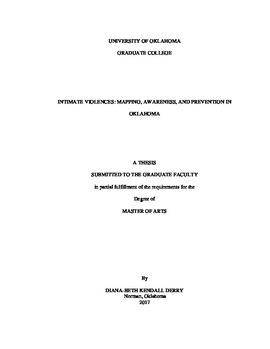| dc.contributor.advisor | Smith, Laurel | |
| dc.contributor.author | Derry, Diana-Beth | |
| dc.date.accessioned | 2017-05-12T16:56:20Z | |
| dc.date.available | 2017-05-12T16:56:20Z | |
| dc.date.issued | 2017-05-12 | |
| dc.identifier.uri | https://hdl.handle.net/11244/50840 | |
| dc.description.abstract | One in three women and one in four men experience intimate partner violence (IPV) in their lifetime. The Centers for Disease Control (2010) reports that 47 percent of women first experience IPV during ages 18-24 and that 38 percent of men first experience it during ages 18-24. Roughly half of the male victims and a third of the female victims of IPV do not report their victimization to the police because they felt it was a “private or personal matter” (Black et al. 2011). African American women are all too often re-victimized by law enforcement and social services agencies, both governmental and non-governmental. They commonly face overt and covert racism in shelters and during police procedures. While “helpseeking” they often have to justify their need for help more than white women do (Hamby 2015; Nnawulezi and Sullivan 2014). This makes black women three to four times more likely than white women to experience death at the hands of a current or past intimate partner (Nnawulezi and Sullivan 2014). Social attitudes and public policies continue to silence the stories of IPV victims after death. This is a two-part project using mixed methods geographic information systems (GIS) and qualitative interviews. The long-term objective of this research is primary prevention and community education programs. First, I created a story map of domestic violence fatalities in Oklahoma using ArcGIS online software. The map I made visualizes the slow burn of violence by representing only some of the victims. Deconstruction illuminates who is missing from the map. Second, I interviewed five college-aged men using map elicitation to ask about their awareness and perception of intimate violences. Using an iterative process to analyze the content of the interviews, I discovered that all participants consider hyper-masculinity problematic and a key contributor to gendered violence. | en_US |
| dc.language | en_US | en_US |
| dc.subject | Geography. | en_US |
| dc.subject | Domestic violence | en_US |
| dc.subject | intimate partner violence | en_US |
| dc.subject | gender violence | en_US |
| dc.subject | DV | en_US |
| dc.subject | IPV | en_US |
| dc.subject | feminist critical geopolitics | en_US |
| dc.title | INTIMATE VIOLENCES: MAPPING, AWARENESS, AND PREVENTION IN OKLAHOMA | en_US |
| dc.contributor.committeeMember | Widener, Jeffery | |
| dc.contributor.committeeMember | Wilson, Janet Sullivan | |
| dc.date.manuscript | 2017-05-10 | |
| dc.thesis.degree | Master of Arts | en_US |
| ou.group | College of Atmospheric & Geographic Sciences::Department Of Geography And Environmental Sustainability | en_US |
| shareok.nativefileaccess | restricted | en_US |
